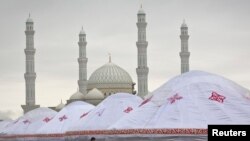Everyone who follows events in Central Asia knows that 2016 is bound to be a difficult year for the region. The respective leaderships in Kazakhstan, Kyrgyzstan, Tajikistan, Turkmenistan, and Uzbekistan probably know this better than anyone.
The big question was: How bad can it get?
I’ve been following events in Central Asia for a while, and winter has always been a slow time. Sometimes there have been incidents -- flare-ups of social unrest in winter -- that affected and were confined to an individual country.
But this winter has been different. Across the region, there has been a flurry of activity, along with a sense of urgency and signs of social strain.
As 2016 started, I decided to follow and record events as closely as possible to see not only what was happening inside these countries but also to pay special attention to how the individual publics responded and what measures each government would take to preserve itself.
I chose to look at the first 40 days of the year, hoping to get a glimpse of where the five countries are heading as this expected worst-of-years begins.
This series looks at each country individually. The focus is on domestic events. Governments in the region are employing similar tactics to avoid any breaking points for the public or social unrest.
All have launched fresh anticorruption campaigns because the people need someone to blame for the hard times they are entering. It is, of course, much better for the public if it is the high and mighty who fall, but it must always be clear that it is not the president who is in any way responsible for the crisis.
Fortunately for the Central Asian leaders, there is an abundance of expendable officials at hand.
All of the governments are also conscious not to allow the national currencies to drop too low and have been burning through their foreign reserves, at least in the three Central Asian states we have information for, to cushion the impact of falling exchange rates.
The typically rigid, uncompromising governments of the region are also showing unusual flexibility by making, so far, small concessions to the people.
They are also, naturally, playing up patriotism and the unity of the nation, and this year’s 25th anniversaries of independence provide a welcome opportunity to divert their nations’ attentions, albeit only temporarily, from deteriorating socioeconomic conditions.
And there is what I am calling in this series "The Great Distraction" -- events and actions designed to do just what Independence Day celebrations will do: Make people forget for a while about their personal problems. It’s an old trick that the Central Asian leaders have obviously not forgotten.
The Central Asian leaders designate each year to be “The Year Of..." The titles of the individual reports in this series note what is being marked in 2016.
Except where noted, all of the information used in preparing this series came from RFE/RL’s Central Asian services.







